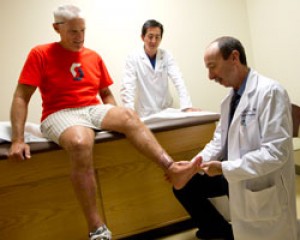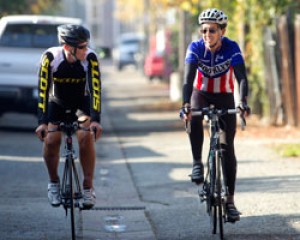Infected Leg Saved, Triathlete Now Looks Forward to His Next Race
Infected Leg Saved, Triathlete Now Looks Forward to His Next Race
Clifford Barnes heard the news in April: He might lose his left leg below the knee. The prospect was almost too much to bear for the 57-year-old triathlete, whose passion is competing in endurance races.
“It hit me really hard,” he said.
Doctors at Stanford Hospital & Clinics had discovered that Barnes’ shinbone and the surrounding tissue had become infected as the result of a compound fracture suffered months earlier. The injury had left the Lodi resident with only one working artery in the lower half of the leg. The combination of an infection and limited blood circulation raised the specter of amputation. But James Chang, MD, chief of the Plastic and Reconstructive Surgery Division, and David Lowenberg, MD, chief of the Orthopaedic Trauma Service, had a plan to avoid that outcome.
They proposed removing the considerable portion of infected tissue and bone just above the ankle, and then transplanting muscle from Barnes’ abdominal wall into the gaping wound.
The operation would be challenging; it would require connecting the intact leg artery to an artery in the transplanted tissue — a procedure called end-to-side vascular anastomosis — to ensure adequate blood perfusion.
Chang is one of the nation’s top hand and microsurgeons, and Lowenberg, an orthopaedic surgeon, one of the world’s leading experts in saving badly damaged limbs. Together with the hospital’s other plastic and orthopaedic surgeons, they have created a limb-salvage program to apply the hospital’s expertise to such cases. A team of six microsurgeons are available at any time to perform these complex operations.
“In my experience — and I’ve been doing this for 22 years — we can usually get patients with these kinds of injuries back to full activity,” Lowenberg said.

David Lowenberg, MD, and James Chang, MD, who collaborated to save the lower part of Clifford Barnes’ left leg, met with the patient in an exam room earlier this winter.
Nevertheless, the surgeons would have to call upon their formidable training and experience to make that happen.
Hit by two cars
Barnes’ fateful journey to a Stanford operating table began almost a year earlier, on June 26, 2010. It was a Saturday morning, and Barnes was on his bike along State Highway 55, a two-lane road just outside of Boise, Idaho. Barnes and his wife, Cathy, both former Idaho residents, were visiting one of their daughters who still lived there. As Barnes pedaled at roughly 20 miles per hour, an SUV clipped him and sent him sprawling onto the pavement. A pick-up truck behind the SUV then ran over both his legs.
“It all happened in the blink of an eye,” Barnes said. “I was conscious. It felt like my legs were lying on hot coals.”
Both cars stopped, and their drivers got out to help. One called 9-1-1, and an ambulance soon was rushing him to a nearby medical center, where doctors cleaned out the wound in his left leg and stabilized the fractures with an external fixator, a device composed of rods and pins to immobilize damaged bone. They also treated broken bones in his right leg. Back in Lodi four weeks later, Barnes went to see a local orthopaedist, who recommended Stanford Hospital. There, Lowenberg replaced the fixator on Barnes’ leg and continued to treat him. Healing of the wound progressed, and in December of 2010 the fixator was removed.
“Life began to return to normal, but there was a small spot, about the size of a dime, that wasn’t healing,” Barnes said. So Chang applied a skin graft to the lesion. A few weeks later, on Easter Sunday, Barnes took a bike ride with one of his daughters. When he got back home, he noticed that a blood blister had formed near the edge of the graft.
He went to see Lowenberg, who discovered the bone infection. It’s possible that a small amount of bacteria was still present from the original accident, Chang said. The tiny aperture next to the graft, where the blood blister had formed, was how the infection was getting oxygen to sustain itself.
Lowenberg and Chang devised a plan to eliminate the infection and use Barnes’ own transplanted tissue to salvage the leg. Barnes agreed to the strategy, but he had one concern: His daughter’s wedding was in a matter of weeks; he wanted to be there. “I wasn’t sure if I was going to make it,” Barnes said.
Lowenberg operated first to remove infected leg tissue and bone, packing the wound with antibiotic beads. “The doctors helped me get to that wedding,” Barnes said. “I thought I would be confined to a wheelchair, but they actually got me up on crutches for it.”
Then on May 23 — two days after the wedding — Chang spent nearly seven hours performing the tissue transplant, with Lowenberg assisting.

After an appointment at Stanford Hospital, Clifford Barnes went on a ride with James Chang, MD, in the Redwood City area.
To cheer up Barnes while he was recovering from the surgery, Chang, a recreational cyclist, told him that they would both ride their road bikes to the coast — through Woodside and past Skyline Boulevard, then down to Highway 1 — once he was better. “His eyes lit up, and he said, ‘That would be awesome,’” Chang recalled.
Today, Barnes’ wound has healed. There is a slight bump where the transplant has merged with the rest of the leg tissue. The bump will grow smaller over time, and Barnes is back on his Scott road bike again, logging as much as 300 miles a week and swimming. He recently started to run again, too, and is planning to compete in a short triathlon in June or July. In August, he plans to compete in an Aquabike race — an endurance competition with swimming and cycling stages — in the Lake Tahoe area. In 2013, he hopes to compete in the Ironman World Championship in Hawaii.
Chang said he is both looking forward to — and feeling somewhat apprehensive about — his planned bike ride this spring with the veteran Ironman competitor. But Barnes said Chang has nothing to worry about; he’ll take it down a few notches so that the surgeon can keep up.
“When I tell people what the Stanford doctors were able to do, they are just astounded,” Barnes said. “I feel blessed to have been able to get Dr. Lowenberg and Dr. Chang. They and the nurses — I can’t say enough good things about the nursing staff — are like family to us.”
By John Sanford
John Sanford is a writer in the communications office at Stanford Hospital & Clinics
Stanford University Medical Center
###
About Stanford Hospital & Clinics
Stanford Hospital & Clinics is known worldwide for advanced treatment of complex disorders in areas such as cardiovascular care, cancer treatment, neurosciences, surgery, and organ transplants. It is currently ranked No. 17 on the U.S. News & World Report’s “America’s Best Hospitals” list and No. 1 in the San Jose Metropolitan area. Stanford Hospital & Clinics is internationally recognized for translating medical breakthroughs into the care of patients. The Stanford University Medical Center is comprised of three world renowned institutions: Stanford Hospital & Clinics, the Stanford University School of Medicine, the oldest medical school in the Western United States, and Lucile Packard Children’s Hospital, an adjacent pediatric and obstetric teaching hospital providing general acute and tertiary care. For more information, visit http://stanfordhospital.org/
Photos by Norbert von der Groeben
###
* Stanford University Medical Center integrates research, medical education and patient care at its three institutions – Stanford University School of Medicine, Stanford Hospital & Clinics and Lucile Packard Children’s Hospital.
** The above story is adapted from materials provided by Stanford University School of Medicine
________________________________________________________________




















